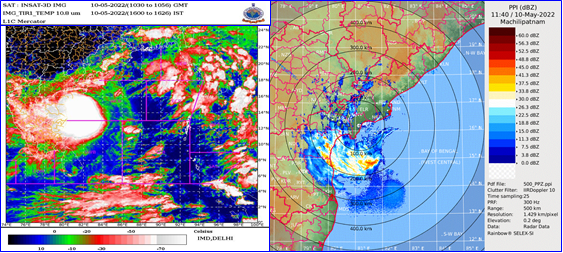By Our Correspondent
NEW DELHI/BHUBANESWAR: A low pressure area formed over South Andaman Sea and adjoining Southeast Bay of Bengalin the morning (0830 hrs IST) of 6th May, 2022. It lay as a well marked low pressure area overSoutheast Bay of Bengal and adjoining south Andaman Sea in the early morning (0530 hours IST) of 7 th May.
Under favourable environmental conditions, it concentrated into a depression over the same region around noon (1130 hrs IST) of same day, the 7 th May, 2022.It moved northwestwards and intensified into a deep depression over southeast Bay of Bengal in the same evening (1730 hrs IST) of 7th May. Continuing to move northwestwards, it intensified into the cyclonic storm “ASANI” in the early morning (0530 hrs IST) of 8th May and into a severe cyclonic storm in the same evening (1730 hrs IST) over southeast Bay of Bengal. Continuing to move northwestwards, it reached peak intensity of 55 knots (100-110 kmph gusting to 120 kmph) on 9th early morning (0530 hrs IST).
It maintained it’s peak intensity till 10th noon (1130 hrs IST), thus for 30 hrs.From 10th evening, it started gradually moving north-northwestwards and weakened into a cyclonic storm over westcentral Bay of Bengal about 60 km south-southeast of Machilipatnam in the early hours (0230 hrs IST) of 11th May. Thereafter, it started moving nearly northwards with a very slow speed and weakened into a deep depression over westcentral Bay of Bengal close to Andhra Pradesh coast in the evening (1730 hrs IST) of 11th May.
It crossed Andhra Pradesh coast near latitude 16.3°N and longitude 81.3°E between Machilipatnam and Narsapur during 1730-1930 hours IST of 11th May, 2022 as a deep depression with maximum sustained wind speed of 55-65 kmph gusting to 75 kmph. It then moved slowly west-southwestwards and weakened into a depression in the early morning (0530 hrs IST) and further into a well marked low pressure area in the morning (0830 hrs IST) of 12th May over coastal Andhra Pradesh.
Salient Features
(i) Weakening before touching coast
The severe cyclonic storm, “ASANI“ weakened into a deep depression before touching the coast mainly due to following reasons:It entered a region with lower sea surface temperature and lower ocean heat contentIt moved very slow (5-6 kmph against normal speed of 13 kmph) near the coast and remained within 50 km from the coastline from morning to evening of 11th May. The slow movement led to upwelling of sea water and rainfall over the Sea leading to further cooling of sea surface.Due to slow movement, there was also land interaction for longer time leading to weakening due to increased friction with land surface. There was cold and dry air incursion from Indian landmass in the middle and upper troposphere which are unfavourable for maintaining the intensity of any cyclonic storm.
(ii) Multiple recurvatures
Severe cyclonic storm “Asani” exhibited multiple recurvatures in its track/path. Most of the models suggested change in direction of movement of the system from northwest to northeast near the coast. However, the deep depression (remnant of cyclone Asani) moved slowly northward/northwestwards on 11th May till evening and slowly west-southwestwards thereafter.It was mainly due to the fact the cyclonic storm was supposed to move northeastwards near thecoast under the influence of a short amplitude westerly trough in middle and upper troposphericlevels approaching from the west. However, as the storm weakened while approaching towardscoast, the height of the storm decreased being limited to middle tropospheric levels. As a resultthe steering wind of the storm changed being dominated by southeasterly winds and led tonorthwestward movement. However, the northwestward movement was restricted/ blocked dueto an anticyclone lying over the peninsular India. Thus, the system moved slowly & remained practically stationary near to the coast followed with slow west-southwestward movement till its weakening into a well marked low pressure area in the morning of 12th May over the region.
Monitoring of Severe Cyclonic Storm, ASANI:
India Meteorological Department (IMD) maintained round the clock watch over the north Indian Ocean and the cyclone was monitored since 28th April, about 8 days prior to the formation oflow pressure area over south Andaman Sea on 6 th May and 9 days prior to the formation of depression over southeast Bay of Bengal. The cyclone was monitored with the help of available satellite observations from INSAT 3D and 3DR, polar orbiting satellites and available ships & buoy observations in the region. The system was also monitored by Doppler Weather RADAR (DWR) Machilipatnam from 10th May morning. Various global models and dynamical-statistical models run by Ministry of Earth Sciences (MoES) institutions, were utilized to predict the genesis, track, landfall and intensity of the cyclone. A digitized forecasting system of IMD was utilized for analysis and comparison of various models’ guidance, decision making process and warning products generation.
First information about likely formation of depression over south Andaman Sea and adjoiningSoutheast Bay of Bengal was released on 28th April in the Extended Range Outlook (about 9days prior to formation of depression). Subsequent information about the development of low pressure area over south Andaman Sea around 6th May and depression around 7th May was issued in the daily Tropical Weather Outlook and the National Weather Forecast Bulletin issued on 29th April about 7 days prior to the formation of low pressure area over south Andaman Sea on 6 th May and 8 days prior to formation of depression over Southeast bay of Bengal.
ii) Cyclone warnings
Considering the development of cyclonic storm over southeast Bay of Bengal, IMD issued first Special Message and Press Release at 1300 hours IST of 6 th May on formation of low pressure area over South Andaman Sea. It was indicated that the system would intensify into a depression by 7th May evening and into a cyclonic storm by 8th May. The message also indicated that the system would move northwestwards and reach westcentral Bay of Bengal off North Andhra Pradesh-Odisha coasts on 10th May. Heavy rainfall, strong wind and tidal waves warnings were issued alongwith advisories for fishermen. Prior to the formation of depression, pre-genesis track was also issued indicating probable point of genesis and path of expected system.
The Special Message and Press Release were further updated on 7 th May on development of well marked low pressure area. iii) Track and intensity forecast The first numbered bulletin issued at 1430 hrs IST of 7th May on formation of depression indicated that the system would intensify into a cyclonic storm on 8th May and would reach close to north Andhra Pradesh coast on 11th May. It was also indicated that the system would gradually recurve northeastwards after reaching close to Andhra Pradesh coast and weaken
gradually. The next bulletin issued at 2120 hrs IST of 7th May further indicated that the system wouldintensify into a cyclonic storm on 8th May morning and into a severe cyclonic storm in theevening of 8th May. It was also indicated that the system would weaken into a cyclonic storm inthe morning of 11th May.Actually, the depression formed on 7th May, intensified into a cyclonic storm in the morning and into a severe cyclonic storm in the evening of 8th May. Thereafter it weakened into a cyclonic storm in the early morning of 11th May. Thus, intensification and weakening were correctly predicted from 7th May itself.
Realised weather:
a) Wind:
The estimated maximum sustained wind speed was about 30 knots (50-60 kmph) along and off Andhra Pradesh coast around the centre of the storm. The High wind speed recorder at IMD, Machilipatnam reported peak wind speed of 30 knots (55 kmph) at 2056 hrs IST of 11th May.
b) Heavy rainfall
The 24 hrs cumulative rainfall (≥7cm) realised at 0830 hrs IST of 11th and 12th May are given belowThe text within the parenthesis next to the place indicates the name of district.
11th May 2022 Coastal Andhra Pradesh & Yanam Narsipatnam (Vishakhapatnam), Kavali (Nellore), Visakhapatnam (Vishakhapatnam), Kandukur (Prakasam), Bapatla (Guntur), Mentada (Vizianagaram), Pusapatirega (Vizianagaram) & Gantyada (Vizianagaram) 7 each.
Rayalaseema Duvvur (YSR) 11, Chapad (YSR) 8 and Cuddapah (YSR), Vallur (YSR), Proddutur (YSR) 7 each. Odisha Anandpur (Keonjargarh) and Ghasipura (Keonjargarh) 7 each 12 th May 2022 Coastal Andhra Pradesh & Yanam Kandukur (Prakasam) 26, Atmakur (Nellore) 20, Bestavaripeta (Prakasam) 13, Kavali (Nellore) & Ongole (Prakasam) 12 each, Racherla (Prakasam) & Cumbum (Prakasam) 11 each Rayalaseema Badvel (YSR) 8 and Atlur (YSR) 7
(vi) Warning advisories issued
A total of 38 National bulletins including 2 special messages for national level disaster managers,7 press releases for print & electronic media, 9 hourly bulletins when system lay close to AndhraPradesh coast, 38 tropical cyclone advisories for WMO/ESCAP Panel member countries, 17 tropical cyclone advisories for International Civil Aviation, 38 advisories for sea area under Global Maritime Distress Safety System, daily video updates, regular updates on social media (facebook, whatsapp, twitter), SMS to disaster managers, general public, fishermen and farmers were issued by IMD Headquarter alongwith with similar action by state level offices at Andhra Pradesh, Odisha, West Bengal, Tamilnadu & Puducherry and Andaman & Nicobar Islands.



























